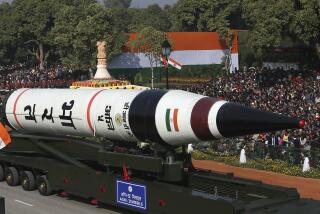Readers React: About that missile shield
Both the $40-billion Midcourse Defense System ordered by President George W. Bush and the $60-billion “Star Wars” system sought by President Reagan were known to be doomed to both strategic and technological failure before the first test. (“$40-billion missile defense system proves unreliable,” June 15)
Reagan’s dream was to develop the capability of shooting down the Soviet Union’s nuclear arsenal and to provide a shield from 10,000 independently targetable warheads traveling at 15,000 miles per hour. Bush set his sights a little lower: He sought protection from Iranian and North Korean threats.
A Pentagon official said we’d need to fire up to three missiles at each target. We now have 30 interceptors that cost more than $1 billion each, although neither North Korea nor Iran possesses the capability we strive to destroy.
How much diplomacy could $100 billion buy?
Kevin H. Park
Encino
Four successful intercept tests in a row with these interceptors took place before their deployment in 2004; this provided high confidence in their reliability. Since then, this interceptor has had three more successful intercepts to provide a 75% confidence level from its last four tests. This same CE-1 interceptor represents the majority of the currently deployed interceptors protecting our nation.
This system was never designed to be reliant on one shot; it operates by firing multiple interceptors at one missile, thereby mathematically increasing its reliability to intercept above 95%.
The program’s problems have been caused by misguided leadership and the lack of investment from the Obama administration. In 2009, the more modern Multiple Kill Vehicle was terminated and a cheaper adaptation to the interceptor was selected. This decision aggravated the problem.
Furthermore, a new contract with Boeing Co. was put in place that incentivized cost-cutting.
Riki Ellison
Alexandria, Va.
The writer is chairman and founder of the Missile Defense Advocacy Alliance.
More to Read
A cure for the common opinion
Get thought-provoking perspectives with our weekly newsletter.
You may occasionally receive promotional content from the Los Angeles Times.






